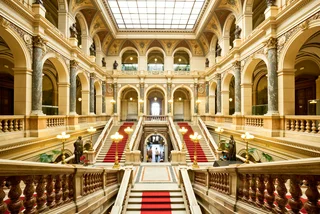The Kings of the Sun exhibition at the National Museum in Prague has been extended to June 6. Currently, the museum is closed due to pandemic restrictions. If restrictions are lifted before June, then people will have another chance to see the objects from Ancient Egypt.
The exhibition of rare artifacts from Egypt had been scheduled to close Feb. 7, as many of the artifacts were supposed to have been returned to other institutions. The Kings of the Sun opened in August 2020, but had to close shortly afterward due to pandemic restrictions. The museum negotiated with the Supreme Council for Monuments of Egypt and other foreign and domestic lenders to extend the loan of the borrowed artifacts.
Objects are on loan from the Egyptian Museum in Cairo, the Great Egyptian Museum in Giza, and museums in Berlin, Leipzig, Hanover, Heidelberg, Hildesheim, and Frankfurt am Main. The exhibition also includes objects that the National Museum acquired as a Czechoslovak contribution to the findings made by Charles University’s expedition of in Abusir.
The Abusir site is part of the pyramid fields stretching from present-day Cairo dozens of kilometers south to the Faiyum Oasis. During the Old and Middle Kingdoms, this area had the largest pyramid complexes of monarchs and burial grounds of members of their families as well as high dignitaries and even ordinary people.
The exhibition offers 300 exhibits, including about 80 artifacts Czech archaeologists uncovered during their five decades of excavations in the Abusir site. It was prepared to mark 100 years of Czech archaeology, celebrated in 2019.

The National Museum management started negotiations with the Supreme Council for Monuments of Egypt and other foreign and domestic lenders about the extension late last year.
“The Kings of the Sun exhibition is one of the most important exhibition projects of the National Museum in its entire history. This is an exceptional exhibition, unfortunately in difficult times. The fact that it was organized last year was a small miracle,” Michal Lukeš, director general of the National Museum, said.
“Since its opening, it has enjoyed great interest from visitors. In recent days, we have received dozens of questions and requests for its extension. I am very pleased to announce today that the Kings of the Sun will remain in the National Museum until June of this year and will continue to delight our visitors even in this difficult time,” Lukeš said.
Due to the pandemic, the exhibition was open for 65 days last summer and autumn, and was visited by over 35,000 people. An exception had been made to keep the exhibition open on Dec. 16, but that only lasted a few days due to the Czech Republic moving to the fifth and highest degree of the PES anti-pandemic restrictions.
“This exhibition is truly a unique achievement in the world context of similar exhibitions," Miroslav Bárta, the director of Czech archaeological research in Egypt and the vice rector of Charles University said.
“I am for all Czech Egyptology and Charles University, co-organizers of the exhibition, very happy that there is space for Czech and foreign visitors to experience a representative collection of discoveries and finds from the pyramid burial ground in Abusir. Many thanks also to our Egyptian friends and colleagues who did their utmost to help us,” he added.
Apart from negotiating with the institutions that loaned the artifacts for the display, the museum also had to negotiate an extension of their insurance and of the relevant state guarantee. The exhibition has an insurance value of CZK 1 billion.
The National Museum says the exhibition is unique not only thanks to rare objects not yet exhibited in the world, but also with its modern concept and design, and the use of multimedia technologies.












 Reading time: 3 minutes
Reading time: 3 minutes 


























